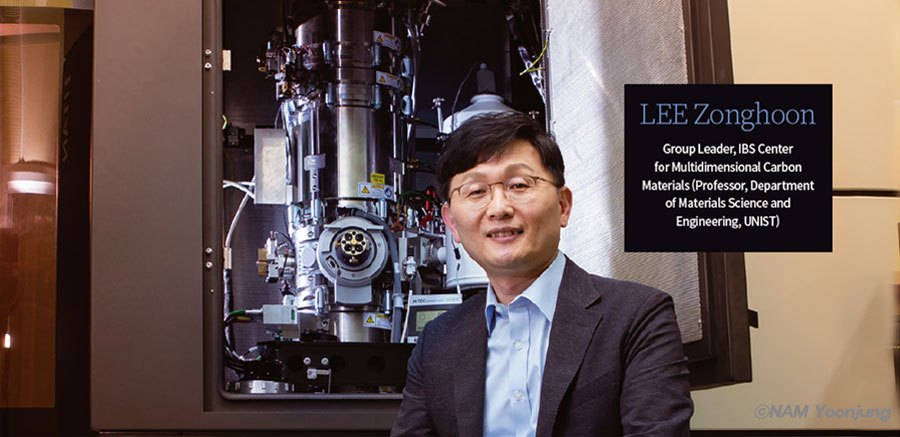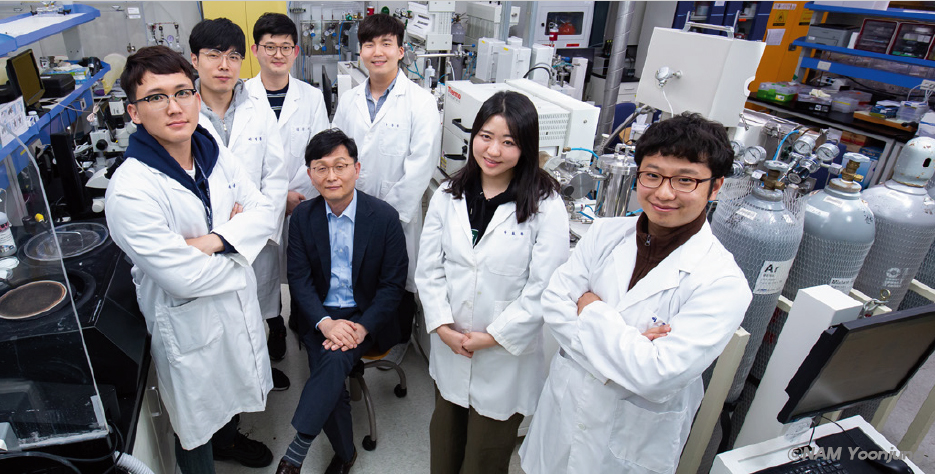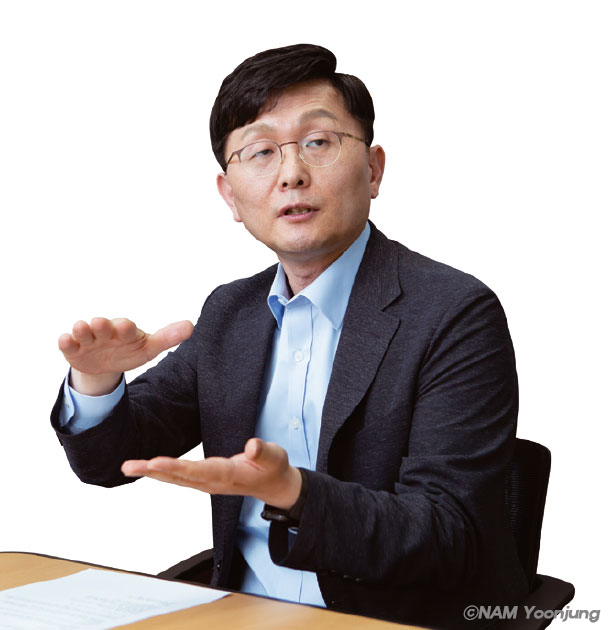주메뉴
- About IBS 연구원소개
-
Research Centers
연구단소개
- Research Outcomes
- Mathematics
- Physics
- Center for Underground Physics
- Center for Theoretical Physics of the Universe (Particle Theory and Cosmology Group)
- Center for Theoretical Physics of the Universe (Cosmology, Gravity and Astroparticle Physics Group)
- Dark Matter Axion Group
- Center for Artificial Low Dimensional Electronic Systems
- Center for Theoretical Physics of Complex Systems
- Center for Quantum Nanoscience
- Center for Exotic Nuclear Studies
- Center for Van der Waals Quantum Solids
- Center for Relativistic Laser Science
- Chemistry
- Life Sciences
- Earth Science
- Interdisciplinary
- Center for Neuroscience Imaging Research (Neuro Technology Group)
- Center for Neuroscience Imaging Research (Cognitive and Computational Neuroscience Group)
- Center for Algorithmic and Robotized Synthesis
- Center for Nanomedicine
- Center for Biomolecular and Cellular Structure
- Center for 2D Quantum Heterostructures
- Institutes
- Korea Virus Research Institute
- News Center 뉴스 센터
- Career 인재초빙
- Living in Korea IBS School-UST
- IBS School 윤리경영


주메뉴
- About IBS
-
Research Centers
- Research Outcomes
- Mathematics
- Physics
- Center for Underground Physics
- Center for Theoretical Physics of the Universe (Particle Theory and Cosmology Group)
- Center for Theoretical Physics of the Universe (Cosmology, Gravity and Astroparticle Physics Group)
- Dark Matter Axion Group
- Center for Artificial Low Dimensional Electronic Systems
- Center for Theoretical Physics of Complex Systems
- Center for Quantum Nanoscience
- Center for Exotic Nuclear Studies
- Center for Van der Waals Quantum Solids
- Center for Relativistic Laser Science
- Chemistry
- Life Sciences
- Earth Science
- Interdisciplinary
- Center for Neuroscience Imaging Research (Neuro Technology Group)
- Center for Neuroscience Imaging Research (Cognitive and Computational Neuroscience Group)
- Center for Algorithmic and Robotized Synthesis
- Center for Nanomedicine
- Center for Biomolecular and Cellular Structure
- Center for 2D Quantum Heterostructures
- Institutes
- Korea Virus Research Institute
- News Center
- Career
- Living in Korea
- IBS School
News Center
| Title | The synergy between IBS and UNIST propels research forward | ||||
|---|---|---|---|---|---|
| Name | Communication Team | Registration Date | 2020-12-31 | Hits | 6294 |
| att. |
 thumb.jpg
thumb.jpg
|
||||
The synergy between IBS and UNIST propels research forwardIn addition to its headquarters in Daejeon, IBS is operating campus research centers at various universities, including five universities specializing in science and technology. This enables researchers to freely engage in research projects under creative topics of their choice and collaborate with one another without the pressure of meeting deadlines. Among them, Ulsan National Institute of Science and Technology (UNIST) is home to three IBS research centers in three different fields that are generating world-class outcomes in basic science research. IBS Research met and heard from researchers who serve as a link between IBS and UNIST about the synergy they have been creating. <First story>“The cooperation between IBS and UNIST helps us remain open to all ideas and march towards a common goal together.”
“I have engaged in many joint research projects with researchers from various fields since my years in the US, but working at IBS took me to a new level. It felt as if there were no barriers between fellow researchers.” LEE Zonghoon, Group Leader at the IBS Center for Multidimensional Carbon Materials (Professor, Department of Materials Science and Engineering, UNIST) pointed to the flexibility in research cooperation as the driving force behind his team’s synergy during his interview at UNIST’s Atomic-Scale Electron Microscopy Lab on October 14. Earilier this year, the team of IBS and UNIST researchers led by Lee achieved the groundbreaking outcome of making a non-conductive material locally conductive in collaboration with Nanyang Technological University of Singapore and Sejong University of Korea. This joint research team built a laminated structure by alternately piling up molecules of h-BN hexagonal boron nitride, which is a 2D non-conductive material, and realized a conductive channel in the structure. The team proved for the first time in the field that an electronic channel with the thickness of a single atom can be arranged in an elongated hexagonal shape along the laminated boundaries where h-BN molecules meet using atomic resolution transmission electron microscopy (TEM). The research result was published in the March 6th issue of Science Advances.* Lee said, “This research result will serve as the basis for the creation of a cutting-edge functional device. The joint research team of IBS and UNIST was able to achieve this feat by marching towards a common goal together.” Lee has been a member of this joint research team since 2019. Rodney Ruoff, Director of the IBS Center for Multidimensional Carbon Materials and Distinguished Professor at UNIST, proposed that he join the team when he was working for UNIST. Professor Ruoff, an acclaimed authority on carbon materials, has been involved in research with Lee for several years
Up until he joined UNIST in 2011, Lee conducted projects at the University of Southern California and at the National Center for Electron Microscopy (NCEM) of Lawrence Berkeley National Laboratory (LBNL) in the US to develop transmission electron microscopy and explore the fundamental structures and properties of nano materials using this technology. In 2004, with the development of technology for separating graphene, dubbed “a dream material”, research on graphene at LBNL also began to gain greater momentum. Through the newly invented aberration-corrected transmission electron microscope, it became possible to see individual carbon atom with the human eye. Lee has focused on observing and analyzing the growth, defects, deformation, and properties of carbon and low-dimensional materials on an atomic level using transmission electron microscopy, as well as on realizing technologies for experimenting with such innovations in real time. One expert cannot manage to carry out tasks of such magnitude all his/her own. Lee explained, “These tasks involve creating materials, calculating the properties displayed by such materials, and analyzing their structures. Thus, scientists in diverse fields, from experimental scientists for handling equipment to theoretical scientists for calculation and analysis, must be brought together and join forces.”
IBS provided an environment optimized for researchers in diverse fields to engage in joint projects. Lee said, “Professors belonging to IBS set common goals and conduct research together to accomplish such goals. Whenever innovative ideas come to mind, we instantly make proposals to explore them and help one another.” The fact that high-priced cutting-edge equipment is available at UNIST also contributed to improving research efficiency. IBS provides support for specialized research equipment needed in addition to those equipped at UNIST. Lee added, “The combination of UNIST’s basic infrastructure and IBS’s capacity for investment in equipment specialized for certain projects created synergy.” Through the cooperation between UNIST and IBS, a stable research foundation for UNIST students. Through joint projects under various long-term themes conducted jointly with IBS researchers without the mental burden of meeting deadlines, UNIST’s quality of fundamental research has continued to advance. Lee said, “Once the COVID-19 pandemic subsides, we plan to push ahead with a series of international joint research projects. We will remain dedicated to accomplishing the goal of exploring and creating the tiniest substance possible in real time through research.” |
|||||
| Next | |
|---|---|
| before |
- Content Manager
- Public Relations Team : Yim Ji Yeob 042-878-8173
- Last Update 2023-11-28 14:20














